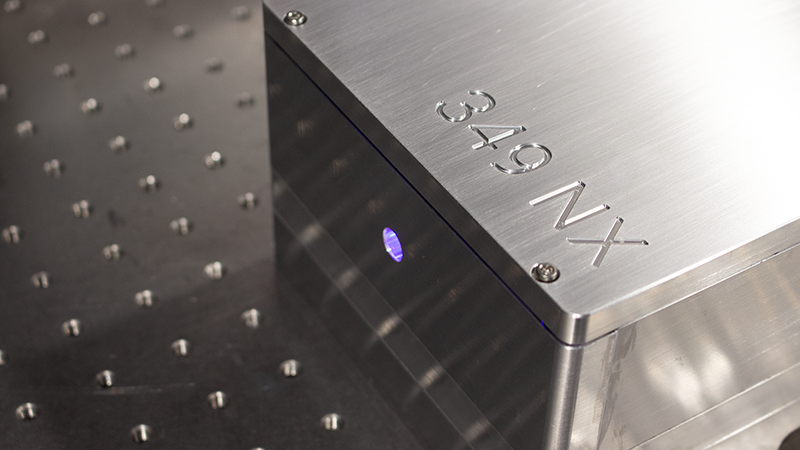
Ultra-reliable, high power ultraviolet DPSS lasers designed to inspect the thinnest features with high resolution
Illuminate large areas and scan an 8 inch wafer in under 90 seconds using high power UV. Our ultraviolet lasers at 320 and 349 nm offer ultra-stable output and precise power control to inspect the thinnest features with high resolution.
Single-frequency diode-pumped solid-state (DPSS) lasers are emerging as a powerful tool in semiconductor inspection applications due to their ability to deliver highly stable, coherent light.
With unmatched precision and non-destructive testing capabilities, single-frequency DPSS lasers provide the control necessary to inspect even the smallest features of advanced semiconductor devices.
Why choose Skylark Lasers for semiconductor inspection?

Skylark Lasers are specifically designed for semiconductor inspection
Skylark NX lasers at 349 nm and 320 nm are the highest power continuous wave lasers on the market, with the Skylark 349 NX laser system delivering up to 400 mW of power.
For semiconductor inspection applications, view our ultraviolet lasers at 320 and 349 nm.
High power
Enables high-speed scans of an 8" wafer in less than 90 seconds.
High stability
Consistent output power and wavelength for reliable and repeatable inspection.
Power control
Precisely controlled laser intensity for fine-tuned interaction with materials.
Long lifetime
Long, no maintenance lifetime to fit into existing maintenance schedules.

What is semiconductor inspection?
Semiconductor inspection is a vital step in the manufacturing of integrated circuits (ICs), or microchips. As semiconductor devices continue to shrink in size, precision in defect detection becomes more critical.
Single-frequency diode-pumped solid-state (DPSS) lasers are emerging as a powerful tool in semiconductor inspection and manufacturing due to their ability to deliver highly stable, coherent light.
These lasers are particularly valuable for semiconductor wafer inspection, where detecting sub-micron defects or imperfections can prevent costly errors and improve overall yield. With unmatched precision and non-destructive testing capabilities, single-frequency DPSS lasers provide the control necessary to inspect even the smallest features of advanced semiconductor devices.

DPSS lasers enable applications in semiconductor inspection and metrology
In semiconductor manufacturing, high-power, single-frequency DPSS lasers facilitate photolithography, metrology, and a broad range of semiconductor structure analysis applications and wafer inspection methods:
-
Wafer metrology
-
Wafer defect detection
-
Thin film metrology
-
Semiconductor material analysis
Their long-term reliability and stability ensure consistent, high-quality results throughout the production process.
By incorporating single-frequency diode-pumped solid-state lasers into semiconductor inspection and manufacturing workflows, manufacturers can achieve superior accuracy, increase throughput, and maintain the stringent quality standards essential in microchip production.
Lasers excite the semiconductor material with light, causing it to emit its own light (photoluminescence). This emitted light reveals information about the material's properties and defects. Variations in the emitted light can indicate impurities, strain, or other issues.
Lasers are used in various interferometric techniques to precisely measure the dimensions of semiconductor features. By splitting a laser beam and analyzing the interaction of the separated beams after they interact with the sample, minute variations in height or thickness can be measured with extreme accuracy.
Optical Critical Dimension (OCD) metrology
This technique uses lasers to measure the critical dimensions (width, height) of features on a semiconductor wafer. Accurate OCD metrology is essential for ensuring the proper functioning of the final electronic device.
Surface roughness measurement
Lasers can be used to analyze the surface roughness of semiconductor materials. Even slight variations in surface smoothness can impact device performance.
Reveal crystal and surface defects in SiC wafers
Easily reveal silicon carbide wafer defects like Micro-pipes, TSD/TED, BPD, and Stacking faults with photoluminescence spectroscopy.
Measure wafer quality with AI assisted detection
Integrate ultra-stable, high power DPSS lasers into your AI assisted defect detection solution for impressive resilience and reliability.
Detect the smallest wafer flaws
Leverage excellent coherence length and ultra narrow linewidth to reveal near-imperceptible wafer faults and defects during semiconductor inspection.
Accelerate scaled wafer metrology
Improve inline metrology throughput with the market leading output power, long term stability, and long lifetime of ultraviolet DPSS lasers.
Detect killer faults with high-precision, reliable performance
Using a high power output, photoluminescence can be generated from silicon carbide to reveal crystal and surface defects in SiC wafers - enabling the critical identification of killer faults during semiconductor manufacturing.


